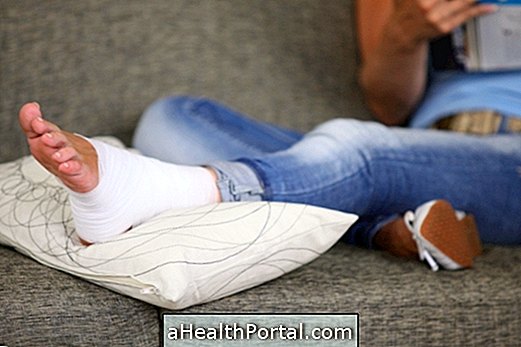Swelling of the feet and ankles is a very common symptom that is usually not a sign of serious problems and is in most cases related to normal changes in circulation, especially in people who spend a lot of time standing or walking, for example.
When swelling in the feet remains swollen for more than 1 day or is accompanied by other symptoms such as pain, severe redness or difficulty walking, it may indicate a problem or injury, such as sprain, infection or even thrombosis.
While in pregnancy, this problem is very common and is usually related to changes in the woman's circulatory system, and rarely is a sign that something is wrong with pregnancy.

1. Poor circulation in the legs and feet
This is the most common cause of swelling in the legs, feet and ankles and usually arises at the end of the day in adults, elderly or pregnant. This poor circulation, while not causing pain, can cause slight discomfort, similar to having heavier feet or full of fluid.
Poor circulation in the legs is a natural process that arises due to the aging of the veins, which makes them less able to push the blood back to the heart and, therefore, the blood is accumulating excessively in the feet and legs.
- What to do: to relieve swelling one should lie down and raise one's legs above the level of the heart. Another option is to do a light massage from the feet to the hip, to help the blood go back to the heart. People who work standing or walk a long time can use elastic compression stockings purchased from pharmacies to prevent the problem from arising, for example. Here's how to use the horse chestnut to improve blood circulation.
2. Twisting and other injuries
Any type of injury or ankle bump can cause a swelling that is accompanied by pain and difficulty in moving the foot, and redness on the side of the foot. One of the most common injuries is sprain, which occurs when the foot is badly placed on the floor or if a foot injury occurs.
In these situations, the ankle and foot ligaments are excessively elongated and, therefore, small fissures may arise, which initiate the inflammatory process leading to the onset of swelling, often accompanied by severe pain, purple spots and difficulty walking or jogging the feet. Often this situation can be confused with a fracture, but it is more likely to be just a sprain.
- What to do: most important in these cases is to put ice on the spot right after the injury, bandage the ankle and give rest to the foot, avoiding intense sports or walking for a long time, at least for 2 weeks. Understand how to treat a heel injury. Another strategy is to place the foot in a basin of warm water and then swapping it into the cold water because this temperature difference will swell the foot and ankle quickly. Watch in the video the steps you must take to make this 'thermal shock' without error:

3. Pre-eclampsia in pregnancy
Although swelling of the ankles is a very common symptom in pregnancy and is not related to serious problems, there are cases in which this swelling is accompanied by other symptoms such as abdominal pain, decreased urination, headache or nausea, for example. In these cases, the swelling may be a sign of pre-eclampsia, which happens when blood pressure is too high and needs to be treated.
- What to do: If pre-eclampsia is suspected, it is very important to consult your obstetrician to have your blood pressure checked. However, to avoid this problem the pregnant woman should take a diet low in salt and increase the intake of water to 2 or 3 liter per day. Learn more about what pre-eclampsia is.
4. Heart Failure
Heart failure is more common in the elderly and is due to the aging of the heart muscle, which has less force to push the blood and therefore accumulates in the legs, ankles and feet by the action of gravity.
Generally, swelling of the feet and ankles in the elderly is accompanied by excessive tiredness, a feeling of shortness of breath and a feeling of pressure in the chest. Get to know other signs of heart failure.
- What to do: Heart failure needs to be treated with medicines prescribed by the doctor and it is therefore advisable to consult a cardiologist to start the appropriate treatment.
5. Thrombosis
Thrombosis occurs when a blood clot can clog one of the veins in the leg, so the blood can not return properly to the heart, accumulating in the legs, feet, and ankles.
In these cases, in addition to the swelling of the feet and ankles, other symptoms such as pain, tingling sensation, intense redness and even low fever may occur.
- What to do: Whenever a thrombosis is suspected, one should go to the emergency room quickly to start treatment with anticoagulants, avoiding that this clot can be transported to other places such as the brain or the heart, which can lead to a heart attack or AVC. See here all the symptoms and how to treat thrombosis.

6. Problems in the liver or kidneys
In addition to heart problems, changes in the functioning of the kidneys or liver can also cause swelling in the body, especially in the legs, feet and ankles.
In the case of the liver this happens due to the diminution of albumin, which is a protein that helps keep the blood inside the vessels. Already in the case of the kidneys, the swelling arises because the liquids are not eliminated properly by the urine.
- What to do : If swelling is frequent and other symptoms such as decreased urination, swelling of the belly, or yellowing of the skin and eyes, it is recommended to consult the general practitioner for blood or urine tests and to identify if there is a problem with the kidneys or liver, for example. Look at the symptoms of liver problems.
7. Infection
The infection associated with swelling of the foot or ankle usually only happens when there is a wound in the foot or leg that is not being treated properly and, therefore, it becomes infected. This situation is more common in people with uncontrolled diabetes who suffer cuts in the feet, but do not feel due to the destruction of the nerves of the feet by the disease.
- What to do: Any infected wound in the diabetic should be treated by a nurse or doctor, and it is recommended to go to the emergency room. Until then, keep the place clean and covered, to avoid the growth of more bacteria. Learn how to identify and treat diabetic foot changes.























